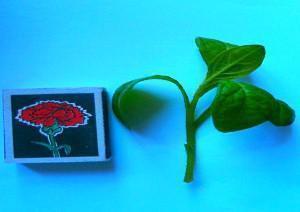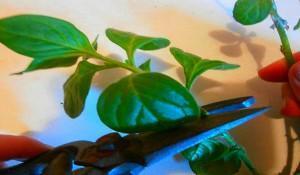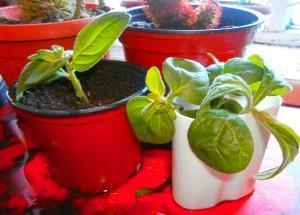Reproduction of petunia by cuttings - rules and tips
 Large-flowered and terry hybrids
, and ampel varieties of petunias have recently become increasingly popular among florists. Unfortunately, it is almost impossible to collect seeds from them, but even if you manage to do it, it is unlikely that something worthy will grow from them. The reproduction of petunias by cuttings allows completely preserving the color and properties of the mother plant you like.
Large-flowered and terry hybrids
, and ampel varieties of petunias have recently become increasingly popular among florists. Unfortunately, it is almost impossible to collect seeds from them, but even if you manage to do it, it is unlikely that something worthy will grow from them. The reproduction of petunias by cuttings allows completely preserving the color and properties of the mother plant you like.
When it comes to breeding petunias, many people choose to buy a bag of seeds and grow seedlings, not even suspecting that there is an easier and much less costly way to do it.
The benefits of propagating petunias by cuttings:
- The ability to save your favorite variety;
- Minimum cash costs for the purchase of seeds and seedlings;
- The obvious simplicity of the method.
In cases where very few plants of a rare species have grown from seeds, they can be propagated by cuttings.
Petunia propagated by cuttings blooms several weeks faster than grown from seed and has a better developed root system.
Summer cuttings

By creating summer conditions for petunia in the middle of winter, you can save your favorite flower. Just with the arrival of autumn, you need to transplant it from the soil into a flower pot and bring it indoors. It is still better not to carry the "old" plant into the house, it is much more correct to pre-cut it in July or early August.
How to propagate petunia by cuttings correctly?
From the cuttings cut from the specimen you like, you need to cut off the flowers and lower leaves, plant it in a flower pot or other container and put it in partial shade for a couple of weeks. The stalk should be approximately 8-10 cm long, with two internodes.
Before planting, its tip can be slightly "powdered" with root. Although some growers are of the opinion that its use is not advisable, and can even harm the plant.
Types of cuttings:
- From the main seedlings;
- From last year's plant from a flower bed;
- Cuttings in water.
Petunia takes root very easily, the main thing is to maintain a sufficient level of moisture. Since with an excess of it, rotting will begin, and with a lack of it, the plant will not grow.
Winter cuttings
 A bright, cool room with a temperature of about 16 degrees is an ideal place for petunias to winter. The lower the temperature, the less light the plants need. Watering during this time should be moderate. From about November preferably illuminate with a lamp... At the beginning of January, after applying nitrogen-containing fertilizers, the backlight should be increased to 16 hours a day.
A bright, cool room with a temperature of about 16 degrees is an ideal place for petunias to winter. The lower the temperature, the less light the plants need. Watering during this time should be moderate. From about November preferably illuminate with a lamp... At the beginning of January, after applying nitrogen-containing fertilizers, the backlight should be increased to 16 hours a day.
When the plants turn into full-fledged bushes, and enough greenery appears, you can start grafting. We carry it out according to the same principle as in the summer. In the prepared soil, the plant is placed on a third of the length of the cutting. When treated with growth stimulants, the deepening is made no more than 1.5 cm.
Within 2 weeks, we keep seedlings under mini greenhouse, which can be used as empty plastic bottles or glass jars. The greenhouse should be ventilated daily to prevent mold growth.The soil should always be moist, so daily spraying with a spray bottle is also recommended.
Reproduction of petunias by cuttings in the same way is done from seedlings. The main seedlings after cutting the cuttings will bush and develop even faster, do not be afraid that you will damage it.
Optimal time and conditions for grafting
Theoretically, you can propagate petunia by cuttings all year round. Proceeding from the fact that after cutting the cuttings it will take about 2 months until the flowering, petunia propagated in this way in March will bloom in early May.
The larger the container in which you plant the plant, the more luxurious the bush will be, and in the case of ampel petunia, the longer the lash. However, if it is necessary to grow a large number of seedlings, plastic cups filled with universal flower soil are most often used. A hole is made in the bottom of the glass, and drainage is placed on the bottom.
The mother bush must be periodically fed with complex fertilizers. As new growth is formed, cuttings are cut from it again. During rooting, petunia does not need feeding. In the future, you can alternate organic and mineral fertilizers.
To improve bushiness, when the first 6-8 leaves appear in the plant, pinch, which is then repeated after a couple of weeks.
Reproduction of petunias by cuttings in water
 Cutting in plain water is another easy way to propagate petunias. From the mother bush, we harvest the top cuttings 10-12 cm long. To prevent them from spoiling in water, remove the lower leaves, leaving only 3-4 of them. It is worth noting that the longer the cuttings remain without a nutrient medium, the less their rooting ability, therefore, they need to be immersed in water as soon as possible.
Cutting in plain water is another easy way to propagate petunias. From the mother bush, we harvest the top cuttings 10-12 cm long. To prevent them from spoiling in water, remove the lower leaves, leaving only 3-4 of them. It is worth noting that the longer the cuttings remain without a nutrient medium, the less their rooting ability, therefore, they need to be immersed in water as soon as possible.
Features of reproduction of petunias in water:
- Choose opaque dishes;
- If the water has evaporated, there is no need to change it, just add a little;
- To create a greenhouse effect, you can cover the container with a transparent cap;
- Terry varieties root better in the soil.
After a week, the stalk will start up roots and can be planted in the soil.
If only half of the specimens emerge from the planted seeds, then with cuttings, with rare exceptions, almost everything is accepted. Provide the seedlings with proper care, and the reproduction of the petunia will certainly be successful.